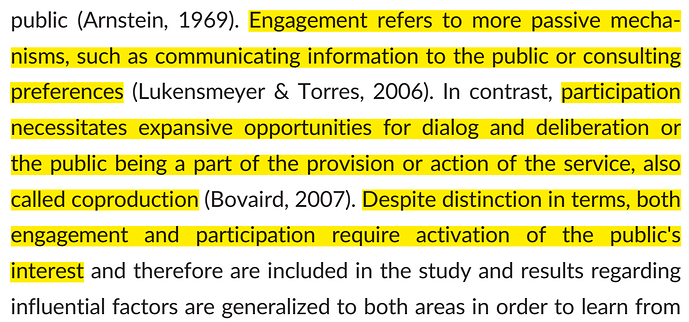منابع و مطالب پیرامون مشارکت شهروندی
تفاوت Engagement با Participation
Schafer, J. G. (2018). A systematic review of the public administration literature to identify how to increase public engagement and participation with local governance. Journal of Public Affairs
2. Policy - Participation
Definition
Members of the public, equally and without discrimination, are able to influence, develop, contribute to, monitor, and evaluate government activities. Governments enable the participation of citizens in their decisions and processes; promote and accept the collaboration with citizens in the production of services; and create spaces and infrastructure for citizens to become involved.
Inclusion The range of participants should reflect and fairly represent the affected stakeholders and diversity of views and interests around the topic without discrimination.
Collaboration Allowing the public to give feedback to government agencies and providing explanations to inform the public’s understanding of policy, processes, and outcomes; ensuring that public participation transforms into regular working partnerships and horizontal collaboration.
Before
Steps you should consider:
- Consider what type of public engagement your policy/project will benefit from. Why do you require public input? What is the most appropriate method of participation?
- Inform the public about the project using an appropriate brief and unbiased presentation of policies.
- Are you making assumptions in the policy design process that come from your particular background and could only be applicable to people similar to you? You can mitigate this by engaging a diverse range of stakeholders to provide input to the project.
- When running consultations, outline expectations, mandate, scope, and follow-up of the process (i.e. clarify the scope of participation and anticipated results to manage expectations and ensure sustained engagement).
- Ensure diversity of participants, e.g. gender, ethnicity, race, class, sectors etc. Invite people with direct, lived experience, in addition to experts.
- Consider using online outreach tools and techniques to enable participation from people who would not be able to physically attend.
- When running online consultations, ensure that the sites are accessible, easy to find, and the consultation process is clearly described.
During
Steps you should consider:
-
When running consultation events, maximise opportunities for people to provide input – the time of day of the consultation can determine what groups are or aren’t able to attend, and this should be taken into consideration (e.g. explore options to host consultation events outside of work/school hours).
-
Ensure accessibility of the events and relevant pre-event content, for instance:
- circulate the agenda in advance
- circulate an advance copy of any slides that will be presented
- host public engagement events in venues with wheelchair access
- reserve front row seats for those with specific needs
- in your online forms, include written descriptions for all images
- transcribe any videos
- increase the text contrast of all your pages to make it more readable for visually-impaired people
- make large print versions of documents available
After
Steps you should consider:
- Seek feedback from the public to identify what part of the process: what form of engagement, what information, etc., had the greatest value to them, and take this feedback into account when designing similar initiatives in the future. This can be done using online surveys or feedback forms after the events.
- Create and use channels to solicit public feedback on both the process of engagement and the outcomes of the policy, for instance, thematic online forum, Slack, designated email address, and/or public Trello board.
Open Government Playbook - HTML version - GOV.UK

